Summary
Click on the pictures to enlarge them and click on the tabs for more information and recommendations.
Budapest is a global city brimming with history and stunning architecture. It is home to world-famous thermal pools, the Castle District, many stunning attractions, and an absolutely wild nightlife.
Budapest—Hungary’s largest city and capital—is a global city specializing in commerce, finance, media, technology, and fashion, among others. And although it’s considered one city, it is essentially two wonderful and distinct cities combined into one—Buda and Pest.
Buda lies to the West of the bisecting Danube River and Pest lies to the East. The Buda Castle, Fisherman’s Bastion, and the Liberty Statue are on the Buda side while Parliament is on the Pest side.
Follow this adventure guide to maximize your time here.
Recommended Duration of Visit
4 days (ideal), 3 days (doable), 2 days (difficult)
Click for some interesting facts about Budapest
Climate: Budapest has the standard humid continental climate with short warm (and often humid summers) and long cold winters. I went during October and the temperature was mild. However, later in the year, it tends to get cold.
Communication: Hungarian is the official language in Budapest. There are English speakers as well, but I would say it’s about half and half. Some people (mostly the younger generations) speak English very well, but some will barely understand you.
Navigation: Unfortunately, there is no Uber in Budapest. There is Bolt, essentially the Uber of Budapest.
Fortunately, there are Lime scooters scattered throughout Budapest. They are quite inexpensive and very fun to use when navigating the city.
There are even motorcycle tours (find more details in the Adventurous Activities section).
Lodging: Generally, lodging is quite inexpensive in Budapest. There are plenty of great Airbnb options as well, and I was able to book an inexpensive location near the center (on the Pest side).
Activities Planning: Budapest is quite inexpensive in general, so there is no need to book a packaged deal. However, the Budapest Card from the Budapest tourism website might make sense if you are planning to use free public transportation and prefer a straightforward way to visit attractions.
As an added bonus, many of the best attractions are free to visit. If you want to learn more, the official Budapest tourism website lists many of the city’s attractions.
Special Considerations
General: Even though Hungary is in the European Union, it does not use the Euro. While the Euro (and sometimes even the United States Dollar) is often accepted, you are much better off using the official currency (shown below). Credit cards are accepted here, some places only accept cash.
Peak Seasons: Summer (June, July, and August) is the peak season. The thermal baths are ideal during the fall and winter. I believe fall (September, October, November) is the best time to go.
Currency: Hungarian Forint (HUF). Currency Converter.
Attractions are paired up based on similarity and/or proximity. All the names provided are easily searchable on Google Maps.
Buda (left of the Danube River) has history and natural sites while Pest (right of the Danube River) is full of festivities.
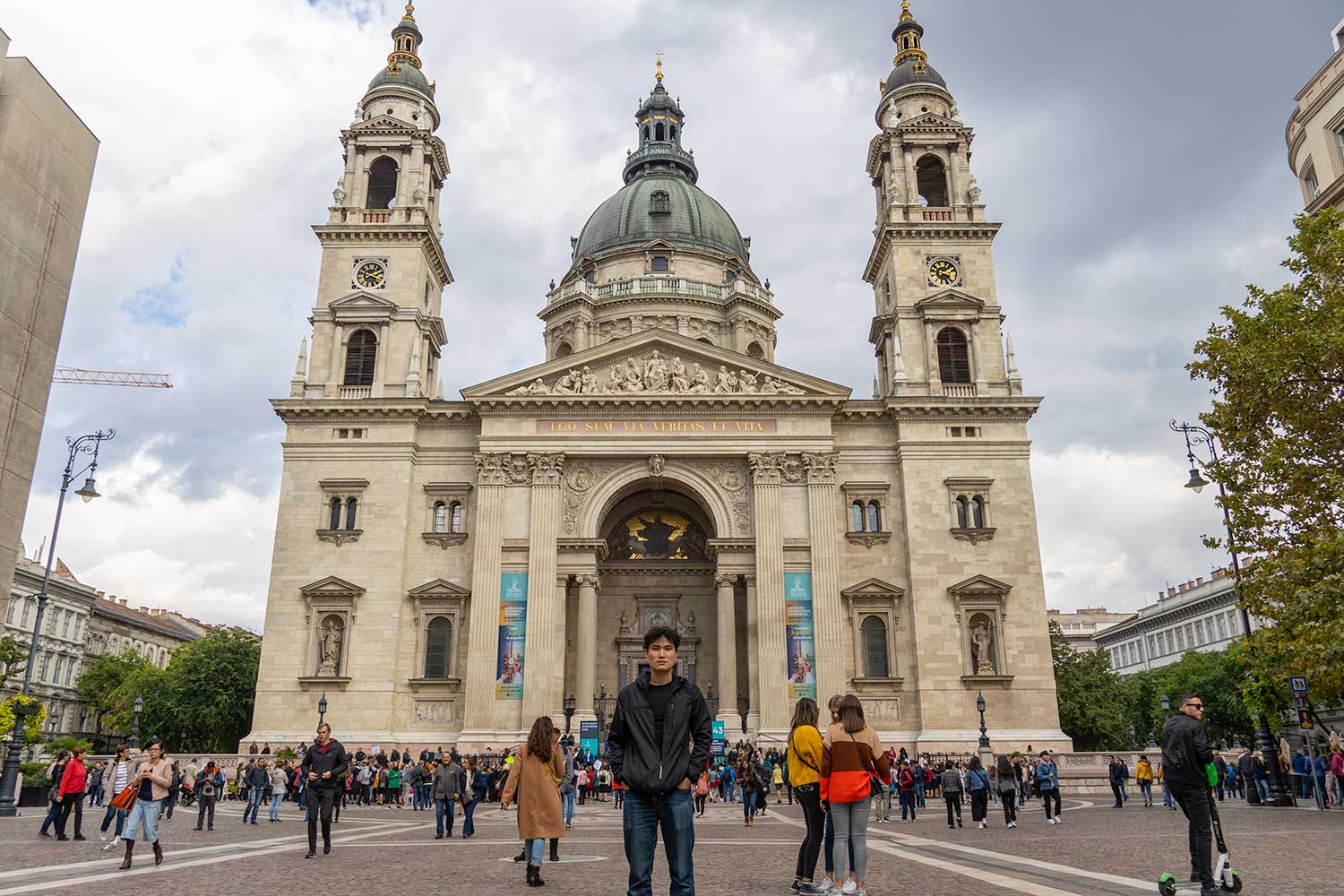 St. Stephen’s Basilica: This Neo-Classical Basilica and the Hungarian Parliament are the two tallest structures in Budapest. Both structures stand at exactly 96 meters (315 feet). As mentioned in the Interesting Facts section, Budapest may never have skyscrapers because no building can be over 96 meters (315 feet) tall. Parliament represents state and St. Stephen’s Basilica represents religion, and no other structures are allowed to be taller.
St. Stephen’s Basilica: This Neo-Classical Basilica and the Hungarian Parliament are the two tallest structures in Budapest. Both structures stand at exactly 96 meters (315 feet). As mentioned in the Interesting Facts section, Budapest may never have skyscrapers because no building can be over 96 meters (315 feet) tall. Parliament represents state and St. Stephen’s Basilica represents religion, and no other structures are allowed to be taller.
This basilica is one of the grandest attractions in Budapest due to its unique architecture and scale. As a bonus, the observation deck provides a centralized panoramic view of Budapest’s skyline.
The Roman Catholic Basilica was named in honor of Saint Stephen I, the first king of Hungary. Incredibly, the king’s “incorruptible” right hand is held in the reliquary. If you refer to my St. Stephen’s Basilica Guide, then you will see how truly amazing this place is.
Cost: The main hall usually requires a small donation. And it costs about 1,000 HUF to enter the observation deck (cash only). Recommended Duration of Visit: 1 – 2 hours.
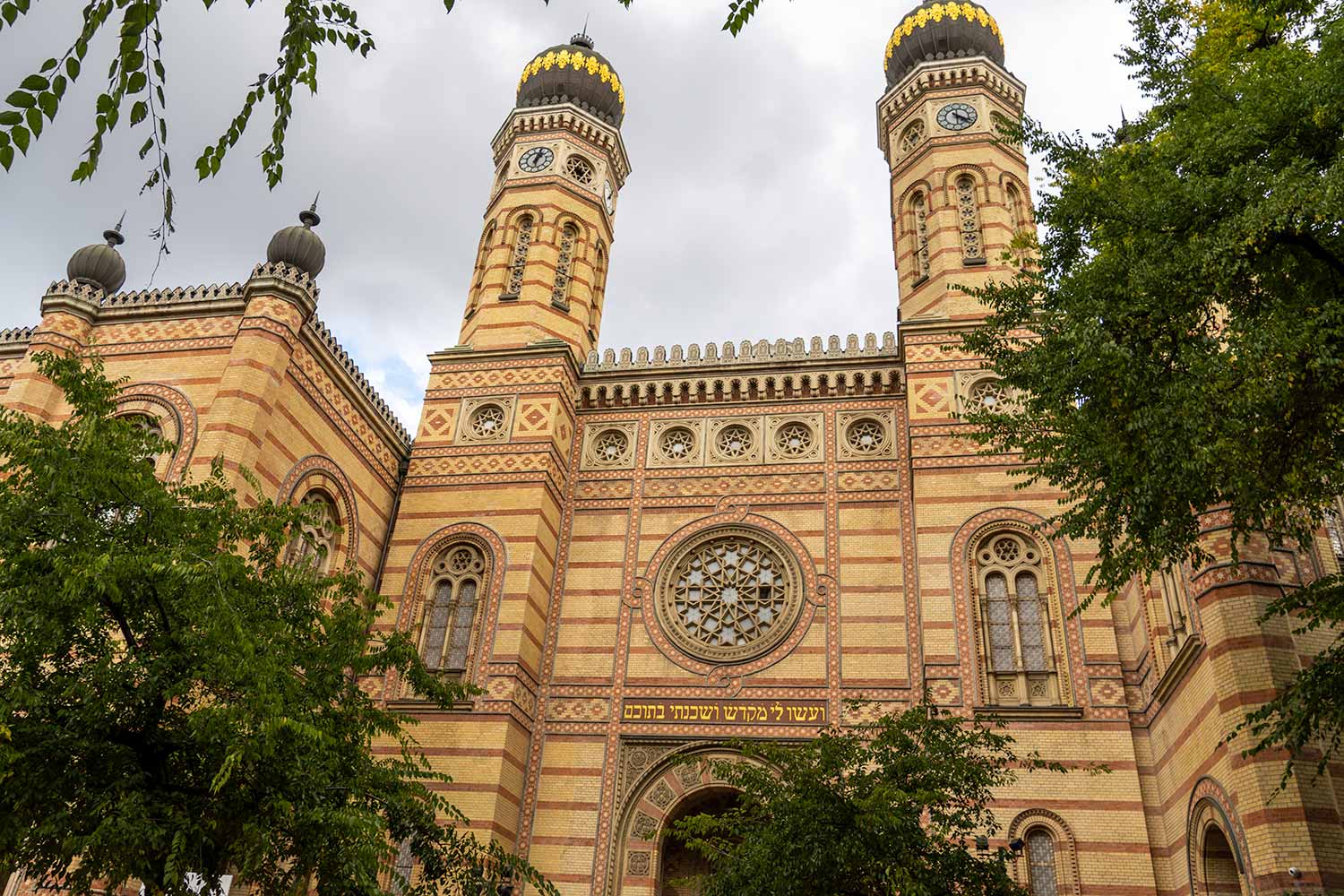 Dohány Street Synagogue: The Dohány Street Synagogue is the largest synagogue in Europe, capable of seating around 3,000 people. This beautiful synagogue is distinct in design, history, and size. It’s comprised of the Great Synagogue, the Jewish Museum, the Heroes’ Temple, and a graveyard.
Dohány Street Synagogue: The Dohány Street Synagogue is the largest synagogue in Europe, capable of seating around 3,000 people. This beautiful synagogue is distinct in design, history, and size. It’s comprised of the Great Synagogue, the Jewish Museum, the Heroes’ Temple, and a graveyard.
The synagogue was also built where Theodor Herzl’s birth home once stood. He was essentially considered the “spiritual father of the Jewish State.” If you refer to my Dohány Street Synagogue Guide, then you will see how truly amazing this place is.
Cost: 4500 HUF. Recommended Duration of Visit: 1 – 2 hours.
| I recommend reaching the observation deck first before it gets crowded. The Basilica is also a short walk away from Liberty Square—a nice scenic park with walking paths and monuments (i.e. the Soviet War Memorial). |
| Men will need to wear a yarmulke to enter the main hall (they will provide it). If you desperately need cash, you can buy an extra ticket with a credit card, ask for a refund, and they’ll give you cash. I did this accidentally. |
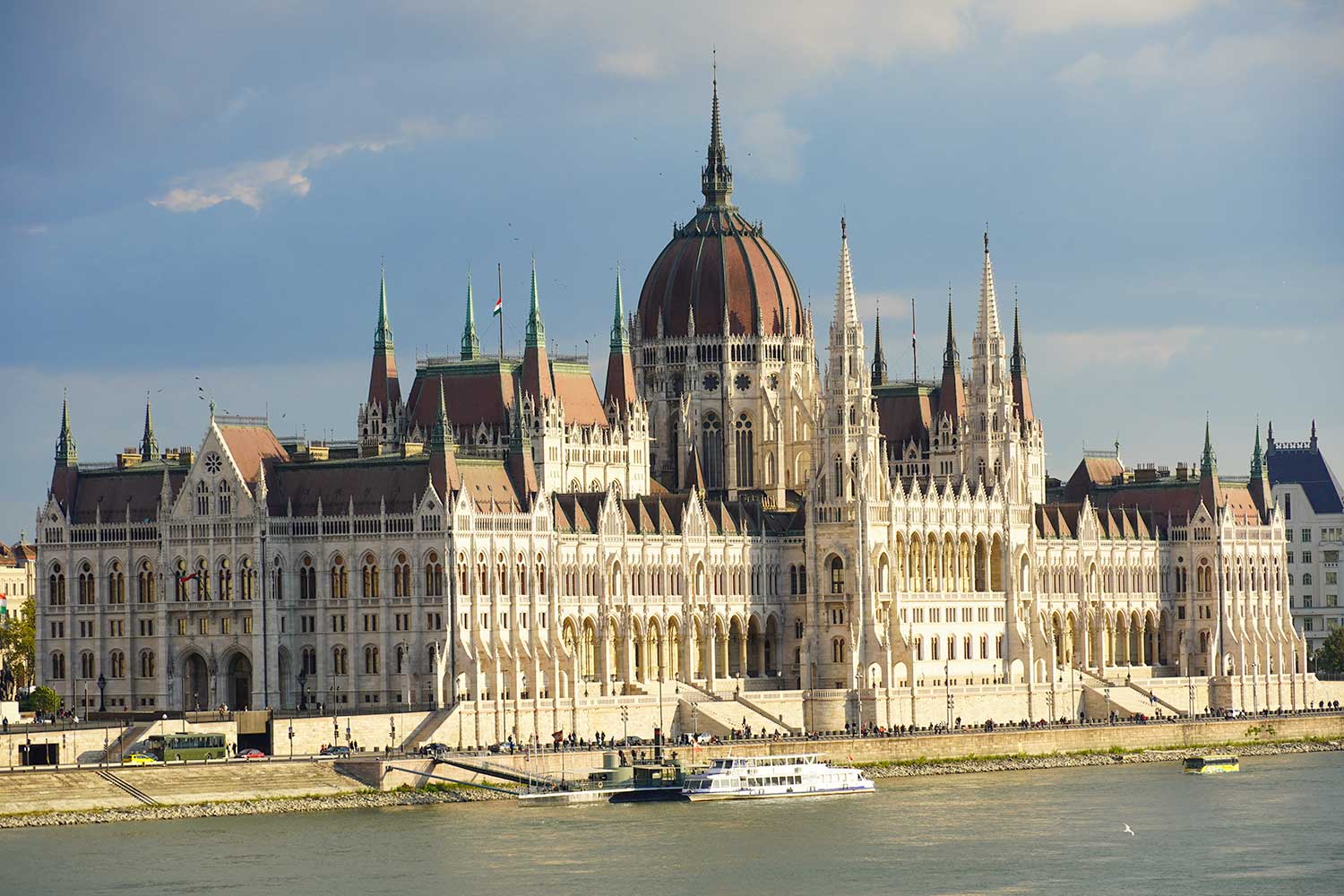 Hungarian Parliament Building: As one of the most easily-recognized, picturesque, and magnificent structures in Budapest, the parliament building is the largest building in Hungary and one of the largest parliament buildings in the world. It is recognized via its Gothic Revival architecture and towering dome.
Hungarian Parliament Building: As one of the most easily-recognized, picturesque, and magnificent structures in Budapest, the parliament building is the largest building in Hungary and one of the largest parliament buildings in the world. It is recognized via its Gothic Revival architecture and towering dome.
Alongside St. Stephen’s Basilica, it is the most important building in Budapest and no other building is allowed to be taller. During the day, guards can be seen patrolling the flag near the front of the building. At night, the building lights up.
Cost: Although you can visit the building by being part of a tour group, I recommend passing on a tour if you are not in the city for very long. Seeing the outside is more than enough. Recommended Duration of Visit: 30 – 60 minutes.
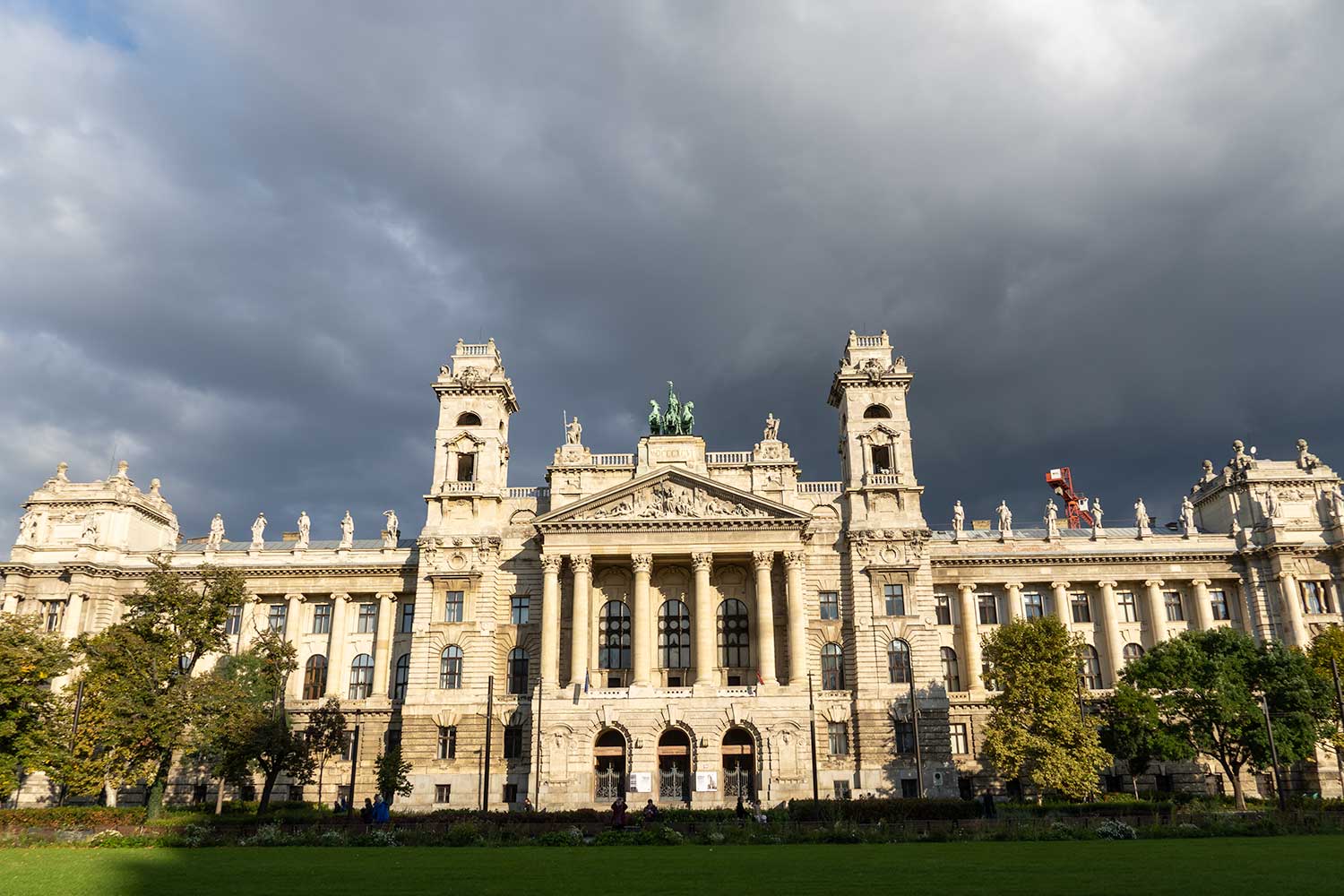 Néprajzi Múzeum (Museum of Ethnography): The Musem of Ethnography is located directly across from the Hungarian Parliament building. It houses a large collection of Hungarian artifacts (art, textiles, pottery, boats, costumes, and furniture, etc.) from various periods throughout history. Some of these artifacts trace back over a thousand years of history.
Néprajzi Múzeum (Museum of Ethnography): The Musem of Ethnography is located directly across from the Hungarian Parliament building. It houses a large collection of Hungarian artifacts (art, textiles, pottery, boats, costumes, and furniture, etc.) from various periods throughout history. Some of these artifacts trace back over a thousand years of history.
Cost: For more information, refer to the official Néprajzi Múzeum website. Recommended Duration of Visit: 15 minutes – 2 hours (if open).
| To find the best vantage points for photography, try taking photos across the Danube River or while on any of the nearby bridges. |
| The museum might be closed for renovations. However, you can still admire many impressive monuments nearby. |
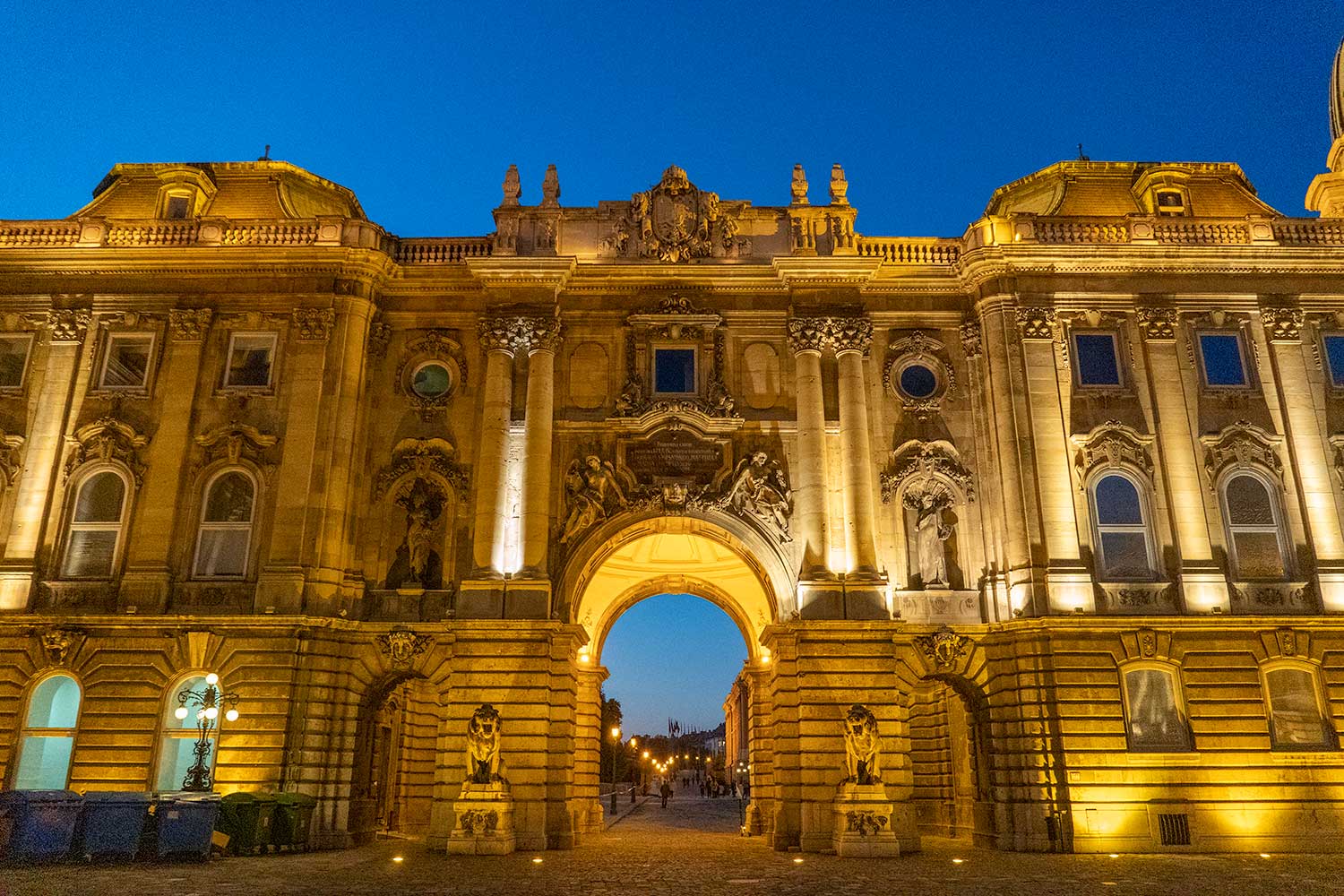 Buda Castle: This palace complex was once the home of Hungarian kings of ages past. The castle now houses the Hungarian National Gallery and the Budapest History Museum. Spanning 1.8 mi2 (4.66 km2), it is simply massive and architecturally gorgeous. The scenic Castle Garden Bazaar is within a short walking distance as well.
Buda Castle: This palace complex was once the home of Hungarian kings of ages past. The castle now houses the Hungarian National Gallery and the Budapest History Museum. Spanning 1.8 mi2 (4.66 km2), it is simply massive and architecturally gorgeous. The scenic Castle Garden Bazaar is within a short walking distance as well.
The castle lies at the top of Castle Hill and is surrounded by incredible houses, monuments, and statues, among others. And since it’s situated at the top of a hill, the castle offers a panoramic view of the city and Danube River.
Cost: It is free to visit the compound, but the museum, national gallery, and library have a small entrance fee. Recommended Duration of Visit: 1 – 2 hours.
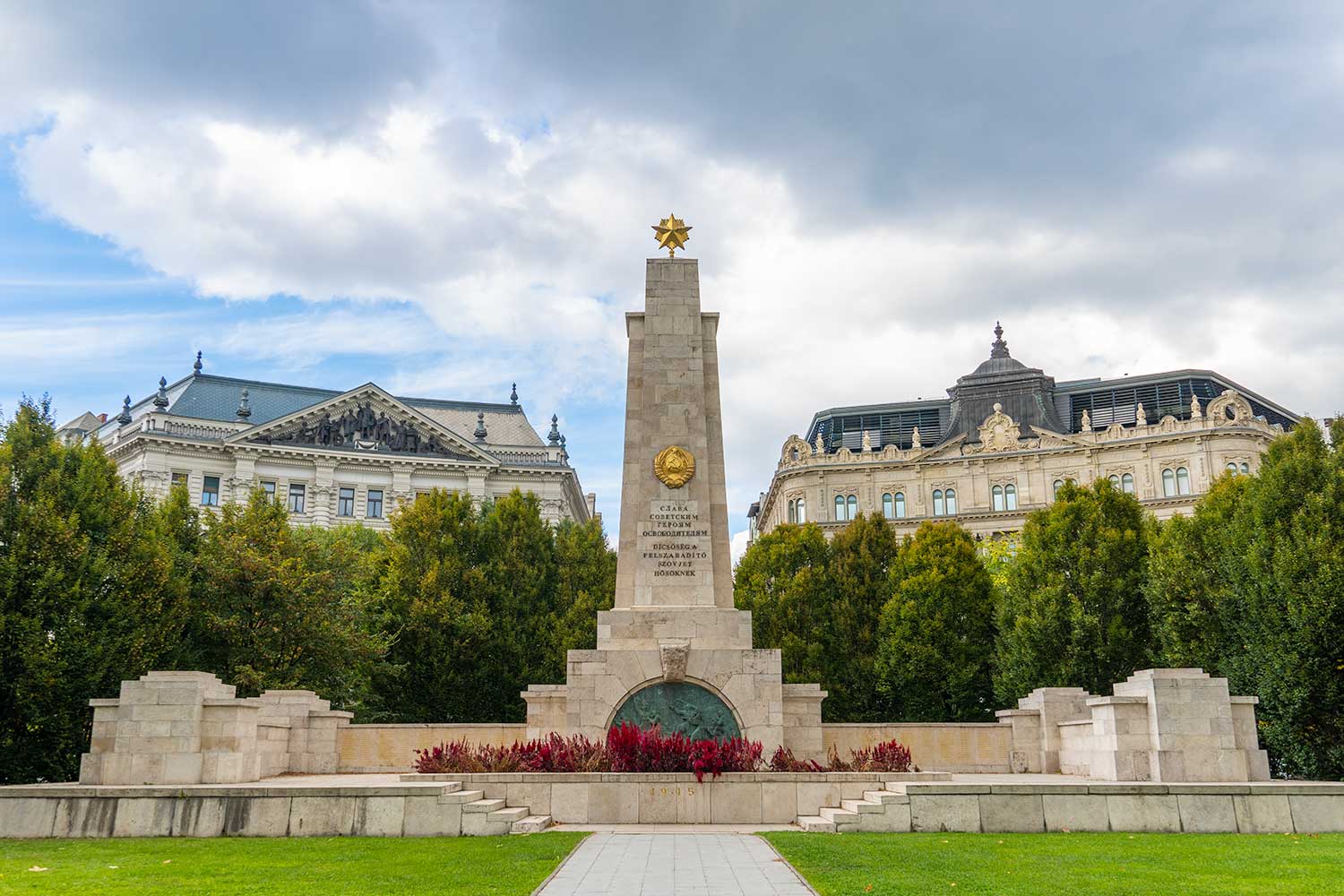 Liberty Square: This public park, located north of St. Stephen’s Basilica, is one of the central hubs in Budapest. It offers a unique mix of restaurants, food stands, cafes, shops, and beautiful architecture.
Liberty Square: This public park, located north of St. Stephen’s Basilica, is one of the central hubs in Budapest. It offers a unique mix of restaurants, food stands, cafes, shops, and beautiful architecture.
The Soviet War Memorial, a Ronald Reagan statue, and the United States Embassy are located nearby as well. During the weekend, a lovely local food market opens up nearby.
Cost: Free to visit. Recommended Duration of Visit: 30 minutes – 2 hours (depending on activity).
| The Budavári Sikló (Budapest Castle Hill Funicular) provides a roundtrip to the castle for 1,800 HUF. |
| The Danube River and Hungarian Parliament are within short walking distance from Liberty Square. |
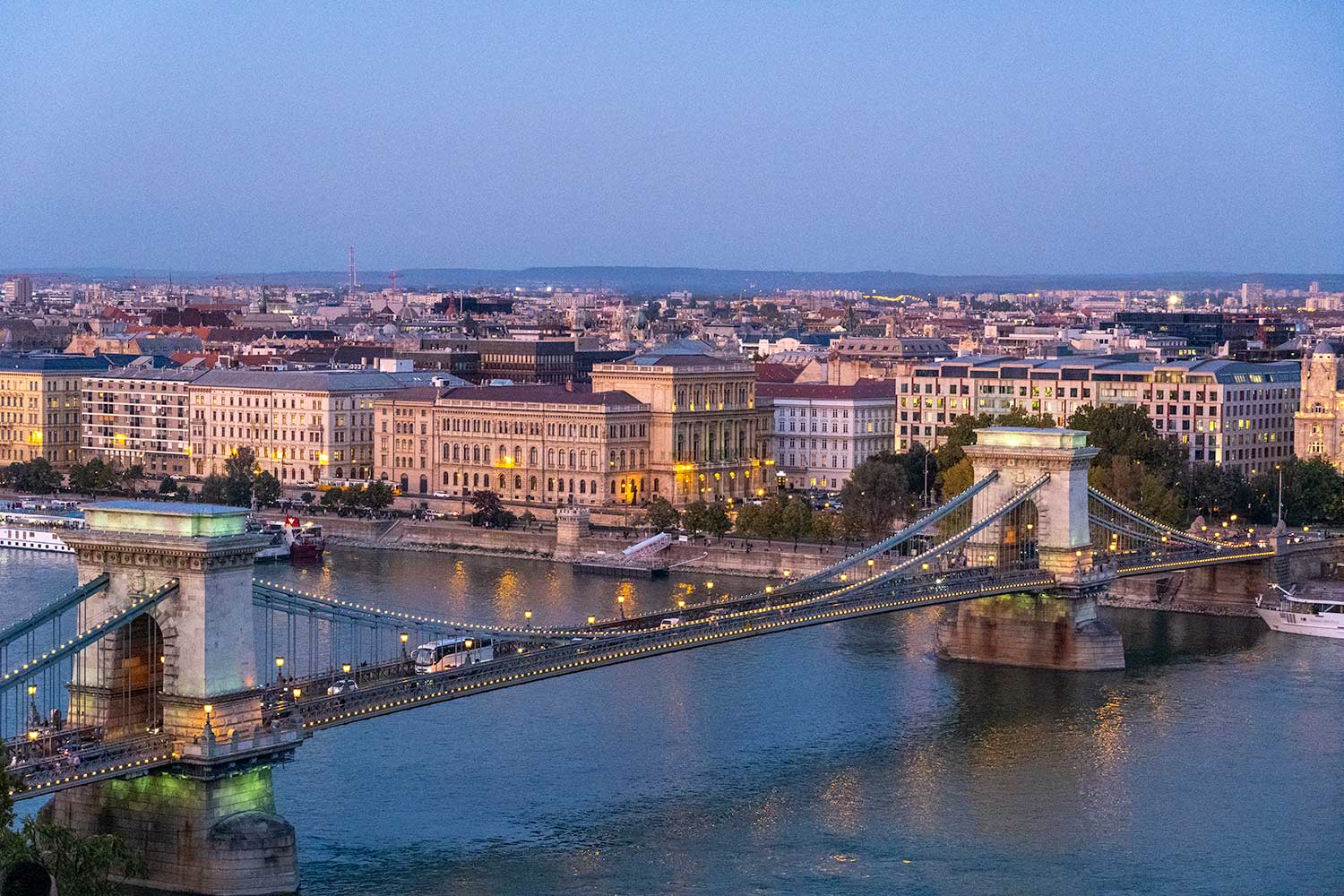 Széchenyi Chain Bridge: As one of the most widely-recognized and popular attractions in Budapest, the Széchenyi Chain Bridge spans the width of the Danube River, connecting Buda and Pest. It is named after István Széchenyi, one of the greatest statesmen in Hungary’s history (often considered the Greatest Hungarian). The bridge is also considered as an engineering wonder and a symbol of advancement, awakening, and the linkage between East and West.
Széchenyi Chain Bridge: As one of the most widely-recognized and popular attractions in Budapest, the Széchenyi Chain Bridge spans the width of the Danube River, connecting Buda and Pest. It is named after István Széchenyi, one of the greatest statesmen in Hungary’s history (often considered the Greatest Hungarian). The bridge is also considered as an engineering wonder and a symbol of advancement, awakening, and the linkage between East and West.
Its significance in Hungary is comparable to the Golden Gate Bridge in California or the Brooklyn Bridge in New York.
Cost: Free to visit. Recommended Duration of Visit: 15 – 30 minutes.
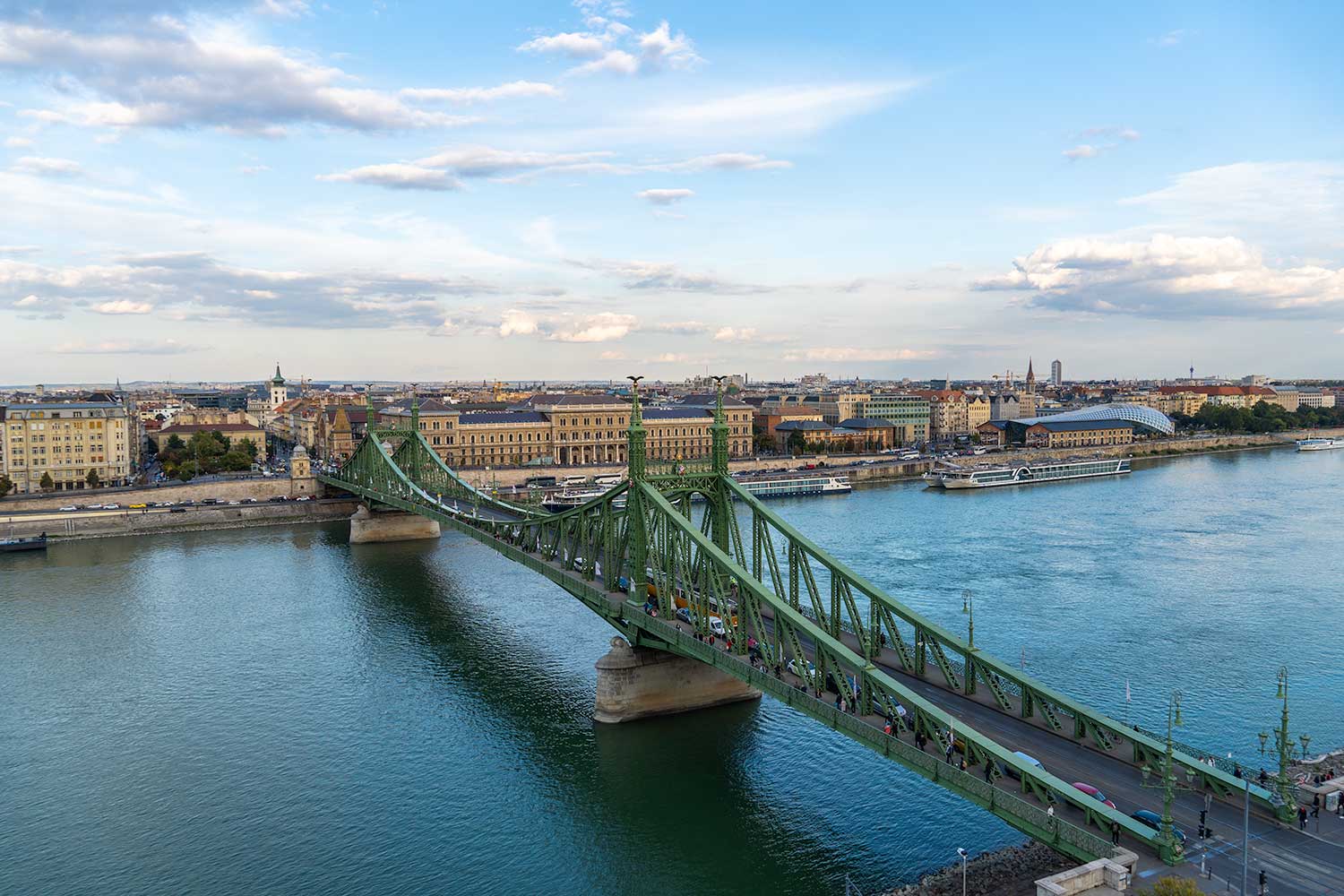 Liberty Bridge: Enjoy a nice leisurely stroll along a bridge that connects Buda and Pest and enjoy an incredible view of the Danube River. The bridge features mythological sculptures, the country’s coat of arms on the side, and two public squares at each end. It is most recognized via the eagles toward the top of the towering totems.
Liberty Bridge: Enjoy a nice leisurely stroll along a bridge that connects Buda and Pest and enjoy an incredible view of the Danube River. The bridge features mythological sculptures, the country’s coat of arms on the side, and two public squares at each end. It is most recognized via the eagles toward the top of the towering totems.
Cost: Free to visit. Recommended Duration of Visit: 15 – 30 minutes.
| Buda Castle lies on the Buda side of the chain bridge. As a bonus, slightly north of the bridge lies some of the most incredible attractions in Budapest: Fisherman’s Bastion and Matthias Church. Another popular bridge, the Elizabeth Bridge, lies to the south of the chain bridge. |
| Certain bridges are more optimal depending on activity. Across the Elizabeth Bridge (on the Buda side) is the Rudas Baths—one of the best thermal baths in Budapest. However, across the Liberty Bridge is the Gellért Thermal Bath—an even more popular thermal bath—and the Liberty Statue. |
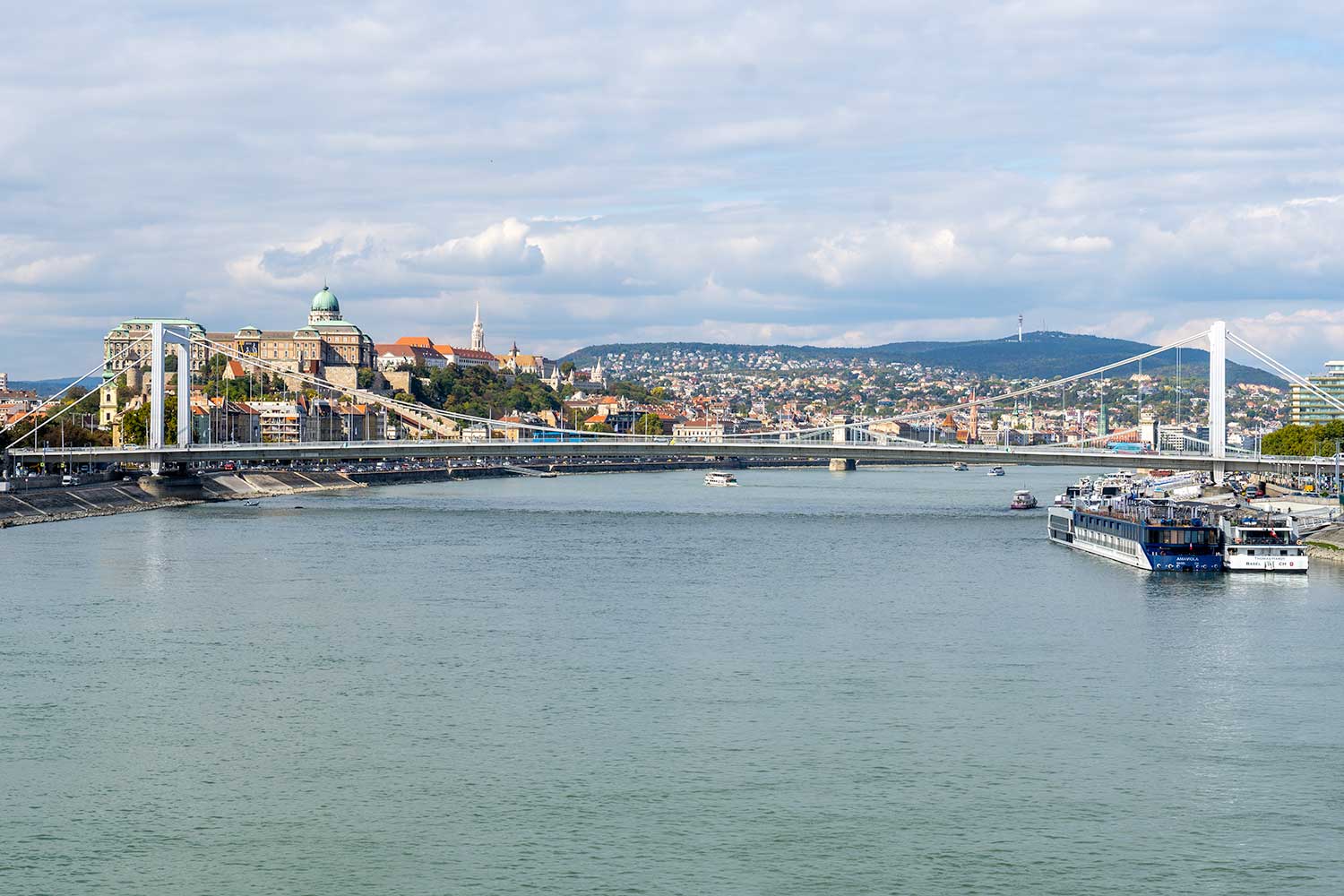 Danube River: The Danube River, an important source of hydropower and drinking water and Europe’s second-longest river, flows through 10 countries (Germany, Austria, Slovakia, Hungary, Croatia, Serbia, Bulgaria, Romania, Moldova, and Ukraine).
Danube River: The Danube River, an important source of hydropower and drinking water and Europe’s second-longest river, flows through 10 countries (Germany, Austria, Slovakia, Hungary, Croatia, Serbia, Bulgaria, Romania, Moldova, and Ukraine).
At 1771 miles (2850 km), this international waterway is one of the most impressive and beautiful in the world. And only the Nile runs through more countries (11 countries).
Cost: Free to visit. Recommended Duration of Visit: 15 – 20 minutes.
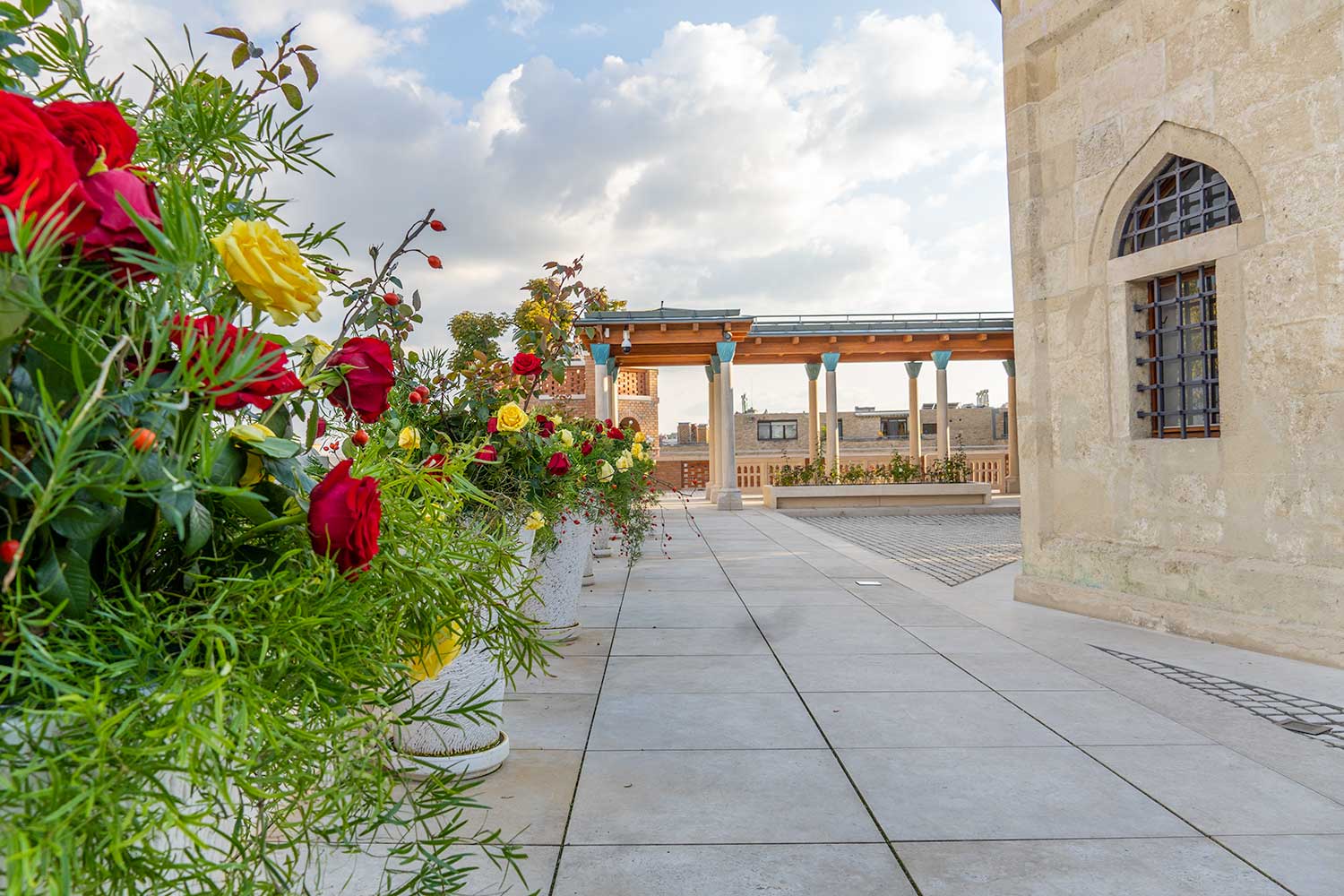 Gül Baba and Rosegarden: Gül Baba was an Ottoman poet. In Hungary, he is known as the “Father of Roses.” His tomb lies in a beautiful rose garden that overlooks the Danube River and Margaret Bridge. In addition to the exhibition spaces, shops, and cafes nearby, the rosegarden is a nice, quiet, and beautiful place away from the bustle of the city.
Gül Baba and Rosegarden: Gül Baba was an Ottoman poet. In Hungary, he is known as the “Father of Roses.” His tomb lies in a beautiful rose garden that overlooks the Danube River and Margaret Bridge. In addition to the exhibition spaces, shops, and cafes nearby, the rosegarden is a nice, quiet, and beautiful place away from the bustle of the city.
Cost: Free to visit. Recommended Duration of Visit: 30 – 60 minutes.
| One of the best views of the Danube River is from the Chain Bridge or the Margaret Bridge, (located north of the Chain Bridge). Naturally, there are options to cruise along the river as well. |
| Since the Rosegarden is elevated, it provides one of the best vantage points for photographing the Hungarian Parliament Building. The Rosegarden is also near the Lucaks Baths. |
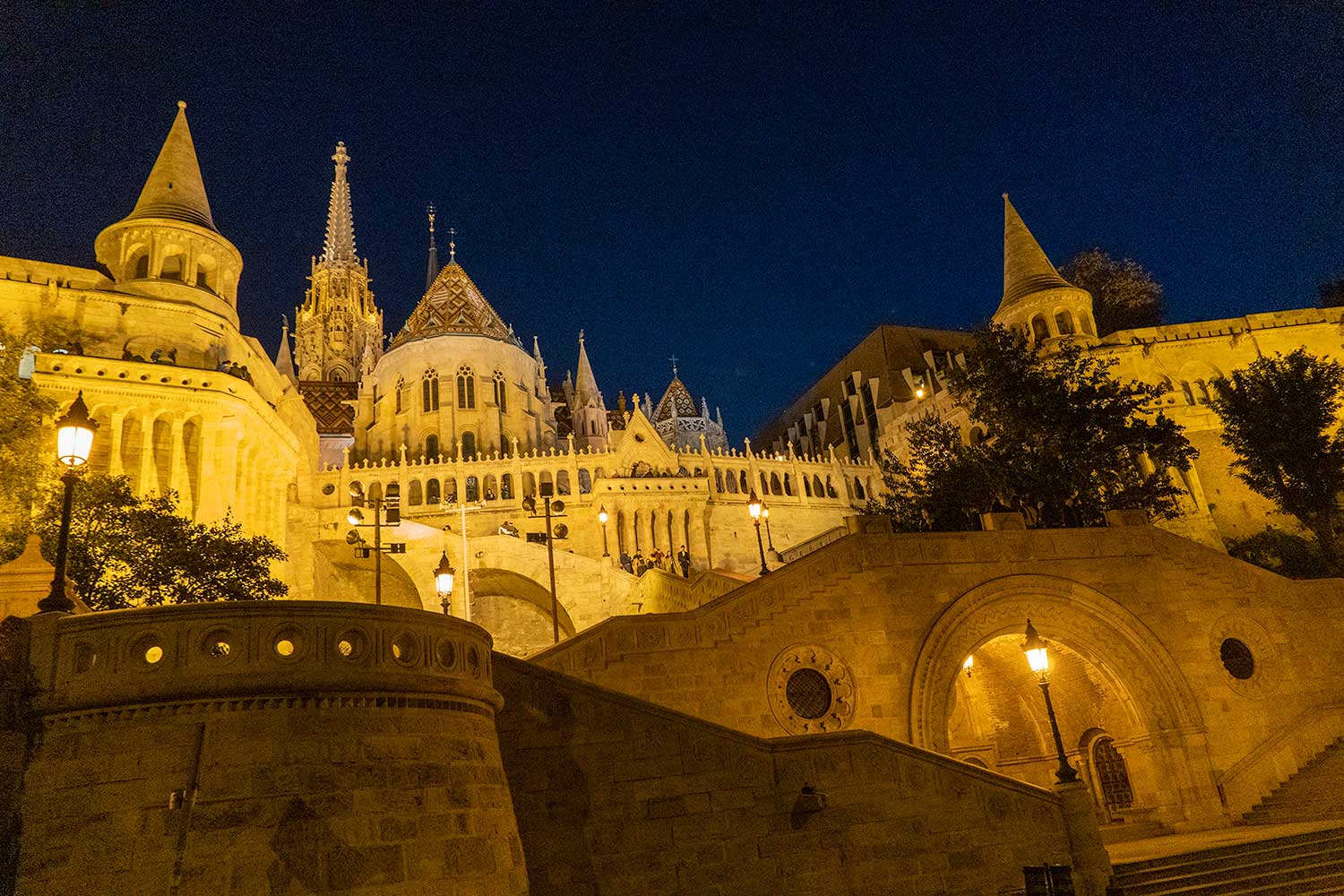 Fisherman’s Bastion: As perhaps the best-known attraction in Budapest, Fisherman’s Bastion is what remains of a turreted fortress of ages past. Due to its elevated position, it offers one of the best panoramic views of Budapest. Its 7 stone towers represent the 7 chieftains who founded Hungary.
Fisherman’s Bastion: As perhaps the best-known attraction in Budapest, Fisherman’s Bastion is what remains of a turreted fortress of ages past. Due to its elevated position, it offers one of the best panoramic views of Budapest. Its 7 stone towers represent the 7 chieftains who founded Hungary.
Historians say that, during the Middle Ages, the castle walls were protected by a guild of fishermen who lived in nearby Fishtown. The current structure, however, is a 19th century recreation of the medieval structure.
Cost: Free to visit. Recommended Duration of Visit: 2 – 3 hours.
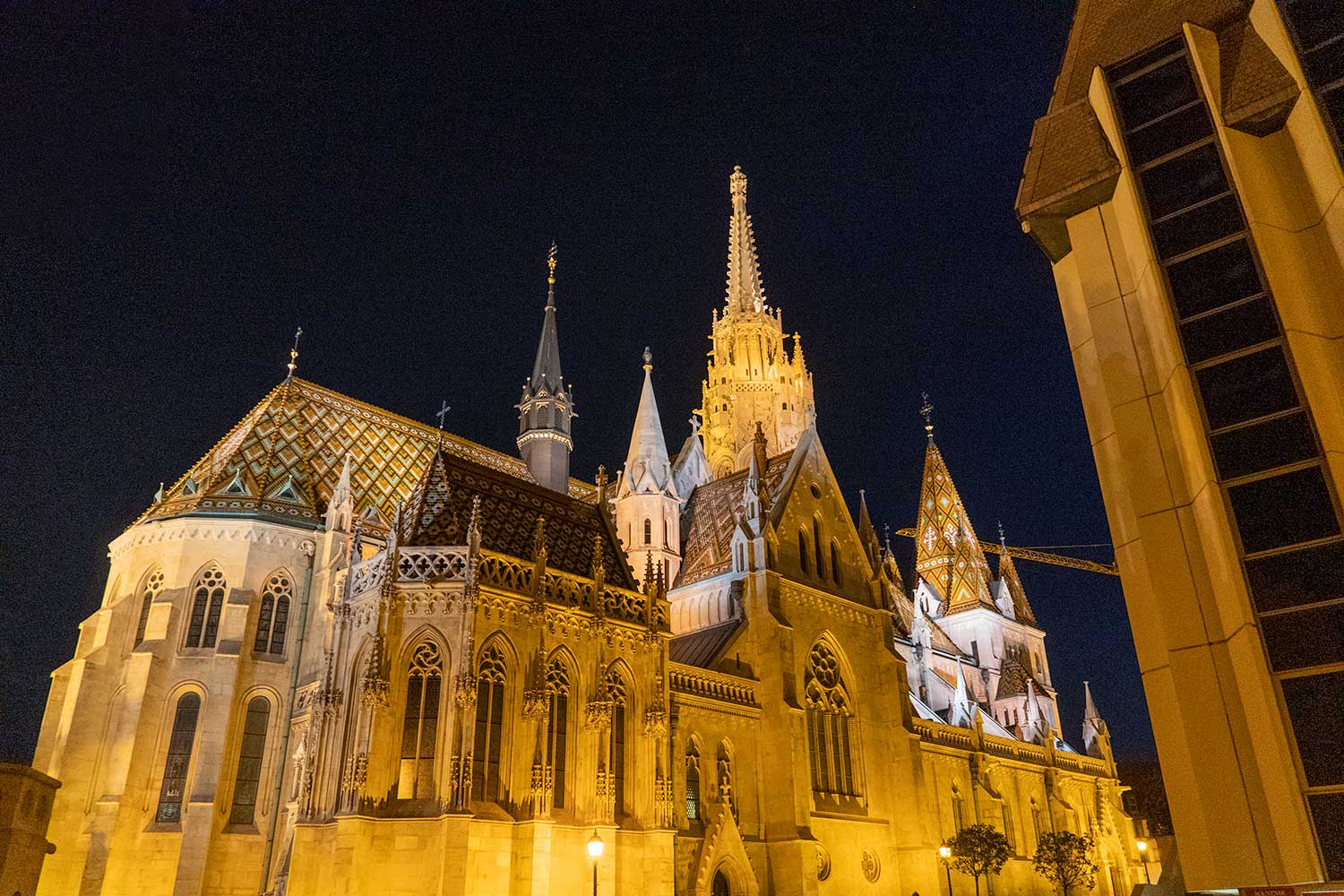 Matthias Church: Within a very short walking distance from Fisherman’s Bastion is Matthias Church, often referred to as the Coronation Church (two kings were crowned within its walls).
Matthias Church: Within a very short walking distance from Fisherman’s Bastion is Matthias Church, often referred to as the Coronation Church (two kings were crowned within its walls).
Paintings, stained glass, and stone carvings dating back to the 1200s adorn the church walls and ceilings. The interior of this massive Roman Catholic church is striking, leaving one in awe of its unique and elaborate architectural design. As a bonus, the view from the tower is spectacular.
Cost: About 1200 HUF. Recommended Duration of Visit: 1 – 2 hours.
| If you visit Fisherman's Bastion at night, the entire structure will be bathed in light. Furthermore, almost every single tour will lead you to Fisherman’s Bastion. |
| Matthias Church and Fisherman's Bastion reside within the massive and festive Castle District. There are hotels, restaurants, and other wonderful attractions in the area worth visiting. |
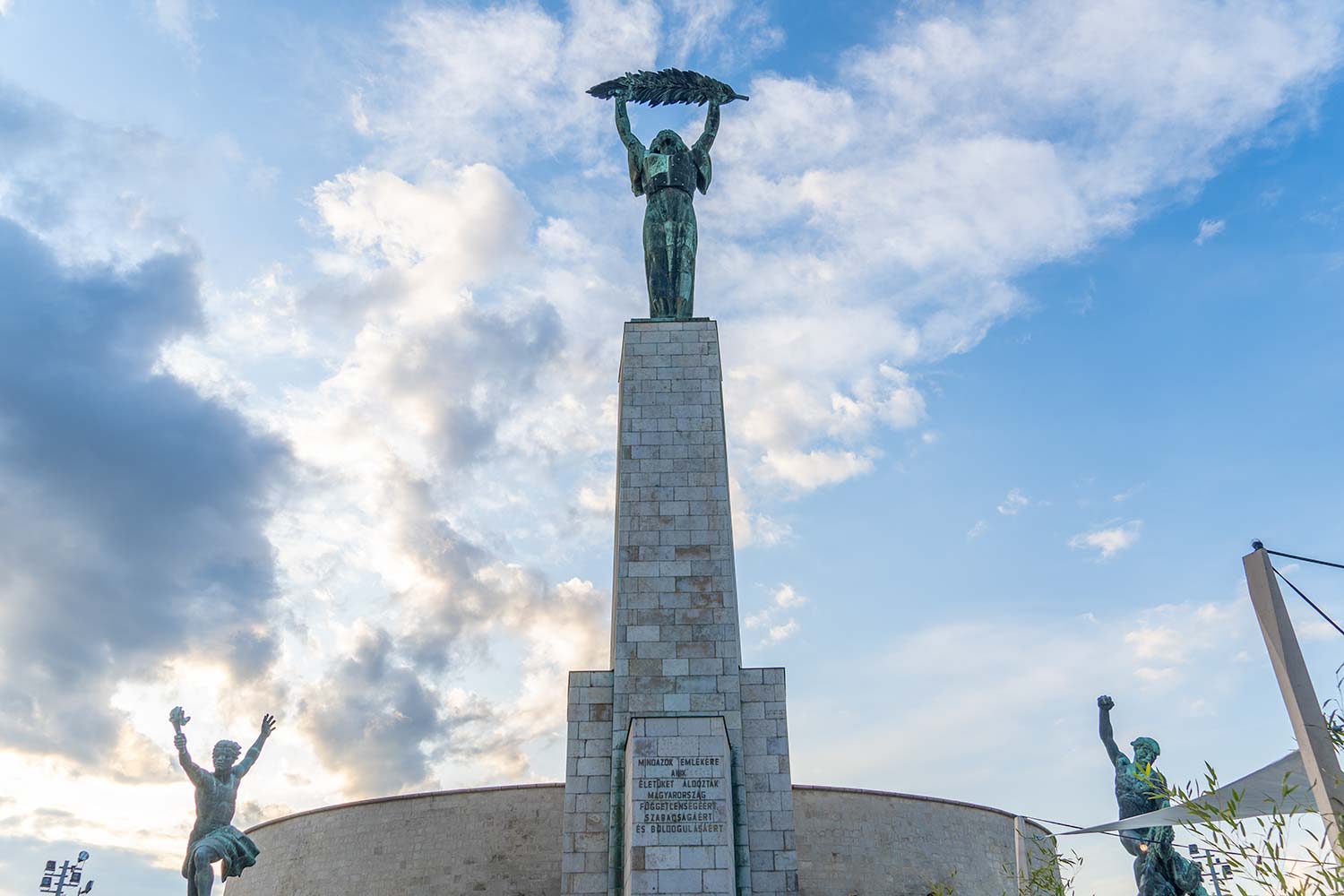 Liberty Statue: The Liberty Statue stands upon the hills of Buda and watches over the city below. Erected in 1947, the statue commemorates the Soviet liberation of Hungary during World War II which ended Nazi occupation. Throughout various parts of Budapest, travelers can often catch a glimpse of this historic monument in the distance.
Liberty Statue: The Liberty Statue stands upon the hills of Buda and watches over the city below. Erected in 1947, the statue commemorates the Soviet liberation of Hungary during World War II which ended Nazi occupation. Throughout various parts of Budapest, travelers can often catch a glimpse of this historic monument in the distance.
And while the statue itself is impressive, the hill upon which it stands is a wonderful hike replete with splendid scenery and panoramic views.
Cost: Free to visit. Recommended Duration of Visit: 2 – 3 hours.
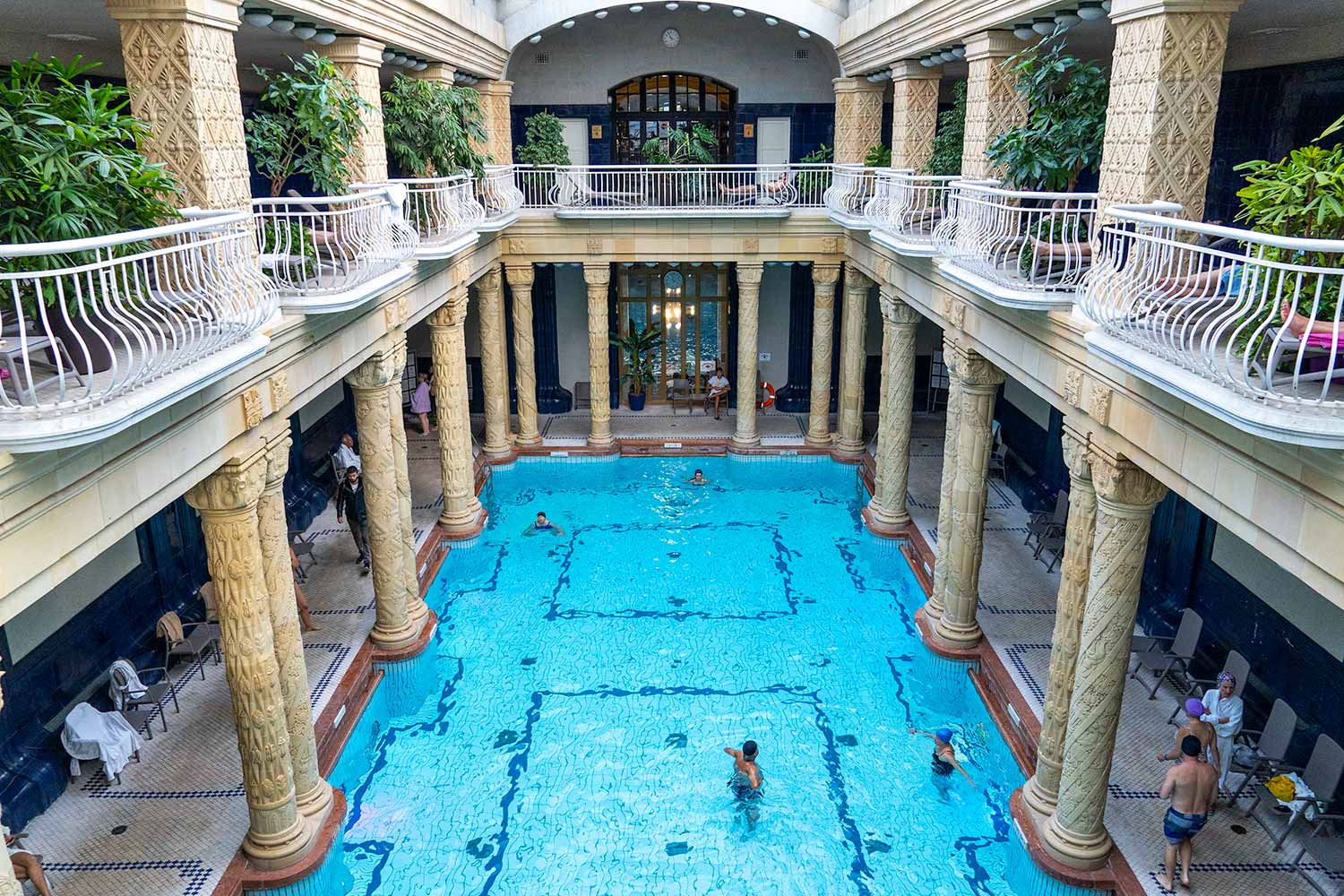 Gellért Thermal Bath: Budapest is sometimes referred to as the “City of Baths.” With some of the best natural thermal baths in the world, Budapest thrives on spa culture. Here, the mineral-rich water is ideal for medicinal purposes and relaxation.
Gellért Thermal Bath: Budapest is sometimes referred to as the “City of Baths.” With some of the best natural thermal baths in the world, Budapest thrives on spa culture. Here, the mineral-rich water is ideal for medicinal purposes and relaxation.
As the second-most-popular Thermal Bath in Budapest, the Gellért Thermal Bath complex offers several swimming pools, numerous smaller thermal baths, 2 main thermal baths (at 40 C and 36 C), and elegant architecture for those seeking a relaxing and fun time.
Cost: Variable depending on the package. Recommended Duration of Visit: 2 – 3 hours.
| The Liberty Statue is right next to a giant fortress (Citadella) that features numerous shops and bars nearby (albeit at inflated prices). Depending on the time of year, the fortress might be open to visitors. At the edge of the hill (near Liberty Bridge) is the Gellért Hill Cave—a Catholic church within a cave. If you see a giant cross, then the cave is within short walking distance. |
| Széchenyi Thermal Bath is actually the most popular thermal bath in Budapest. However, despite residing in a beautiful park, the bath is quite far from central Budapest. On the other hand, The Gellért Thermal Bath is conveniently located near many top attractions. Two other very popular baths are Lukacs Baths (near the Rosegarden) and Rudas Baths (near the Elisabeth Bridge). |
Attractions are paired up based on similarity and/or proximity. All the names provided are easily searchable on Google Maps.
Buda (left of the Danube River) has history and natural sites while Pest (right of the Danube River) is full of festivities.
 St. Stephen’s Basilica: This Neo-Classical Basilica and the Hungarian Parliament are the two tallest structures in Budapest. Both structures stand at exactly 96 meters (315 feet). As mentioned in the Interesting Facts section, Budapest may never have skyscrapers because no building can be over 96 meters (315 feet) tall. Parliament represents state and St. Stephen’s Basilica represents religion, and no other structures are allowed to be taller.
St. Stephen’s Basilica: This Neo-Classical Basilica and the Hungarian Parliament are the two tallest structures in Budapest. Both structures stand at exactly 96 meters (315 feet). As mentioned in the Interesting Facts section, Budapest may never have skyscrapers because no building can be over 96 meters (315 feet) tall. Parliament represents state and St. Stephen’s Basilica represents religion, and no other structures are allowed to be taller.
This basilica is one of the grandest attractions in Budapest due to its unique architecture and scale. As a bonus, the observation deck provides a centralized panoramic view of Budapest’s skyline.
The Roman Catholic Basilica was named in honor of Saint Stephen I, the first king of Hungary. Incredibly, the king’s “incorruptible” right hand is held in the reliquary. If you refer to my St. Stephen’s Basilica Guide, then you will see how truly amazing this place is.
Cost: The main hall usually recommends a small donation. And it costs about 1,000 HUF to enter the observation deck (cash only). Recommended Duration of Visit: 1 – 2 hours.
| I recommend reaching the observation deck first before it gets crowded. The Basilica is also a short walk away from Liberty Square—a nice scenic park with walking paths and monuments (i.e. the Soviet War Memorial). |
 Dohány Street Synagogue: The Dohány Street Synagogue is the largest synagogue in Europe, capable of seating around 3,000 people. This beautiful synagogue is distinct in design, history, and size. It’s comprised of the Great Synagogue, the Jewish Museum, the Heroes’ Temple, and a graveyard.
Dohány Street Synagogue: The Dohány Street Synagogue is the largest synagogue in Europe, capable of seating around 3,000 people. This beautiful synagogue is distinct in design, history, and size. It’s comprised of the Great Synagogue, the Jewish Museum, the Heroes’ Temple, and a graveyard.
The synagogue was also built where Theodor Herzl’s birth home once stood. He was essentially considered the “spiritual father of the Jewish State.” If you refer to my Dohány Street Synagogue Guide, then you will see how truly amazing this place is.
Cost: 4500 HUF. Recommended Duration of Visit: 1 – 2 hours.
| Men will need to wear a yarmulke to enter the main hall (they will provide it). If you desperately need cash, you can buy an extra ticket with a credit card, ask for a refund, and they’ll give you cash. I did this accidentally. |
 Hungarian Parliament Building: As one of the most easily-recognized, picturesque, and magnificent structures in Budapest, the parliament building is the largest building in Hungary and one of the largest parliament buildings in the world. It is recognized via its Gothic Revival architecture and towering dome.
Hungarian Parliament Building: As one of the most easily-recognized, picturesque, and magnificent structures in Budapest, the parliament building is the largest building in Hungary and one of the largest parliament buildings in the world. It is recognized via its Gothic Revival architecture and towering dome.
Alongside St. Stephen’s Basilica, it is the most important building in Budapest and no other building is allowed to be taller. During the day, guards can be seen patrolling the flag near the front of the building. At night, the building lights up.
Cost: Although you can visit the building by being part of a tour group, I recommend passing on a tour if you are not in the city for very long. Seeing the outside is more than enough. Recommended Duration of Visit: 30 – 60 minutes.
| To find the best vantage points for photography, try taking photos across the Danube River or while on any of the nearby bridges. |
 Néprajzi Múzeum (Museum of Ethnography): The Musem of Ethnography is located directly across from the Hungarian Parliament building. It houses a large collection of Hungarian artifacts (art, textiles, pottery, boats, costumes, and furniture, etc.) from various periods throughout history. Some of these artifacts trace back over a thousand years of history.
Néprajzi Múzeum (Museum of Ethnography): The Musem of Ethnography is located directly across from the Hungarian Parliament building. It houses a large collection of Hungarian artifacts (art, textiles, pottery, boats, costumes, and furniture, etc.) from various periods throughout history. Some of these artifacts trace back over a thousand years of history.
Cost: For more information, refer to the official Néprajzi Múzeum website. Recommended Duration of Visit: 15 minutes – 2 hours (if open).
| The museum might be closed for renovations. However, you can still admire many impressive monuments nearby. |
 Buda Castle: This palace complex was once the home of Hungarian kings of ages past. The castle now houses the Hungarian National Gallery and the Budapest History Museum. Spanning 1.8 mi2 (4.66 km2), it is simply massive and architecturally gorgeous. The scenic Castle Garden Bazaar is within a short walking distance as well.
Buda Castle: This palace complex was once the home of Hungarian kings of ages past. The castle now houses the Hungarian National Gallery and the Budapest History Museum. Spanning 1.8 mi2 (4.66 km2), it is simply massive and architecturally gorgeous. The scenic Castle Garden Bazaar is within a short walking distance as well.
The castle lies at the top of Castle Hill and is surrounded by incredible houses, monuments, and statues, among others. And since it’s situated at the top of a hill, the castle offers a panoramic view of the city and Danube River.
Cost: It is free to visit the compound, but the museum, national gallery, and library have a small entrance fee. Recommended Duration of Visit: 1 – 2 hours.
| The Budavári Sikló (Budapest Castle Hill Funicular) provides a roundtrip to the castle for 1,800 HUF. |
 Liberty Square: This public park, located north of St. Stephen’s Basilica, is one of the central hubs in Budapest. It offers a unique mix of restaurants, food stands, cafes, shops, and beautiful architecture.
Liberty Square: This public park, located north of St. Stephen’s Basilica, is one of the central hubs in Budapest. It offers a unique mix of restaurants, food stands, cafes, shops, and beautiful architecture.
The Soviet War Memorial, a Ronald Reagan statue, and the United States Embassy are located nearby as well. During the weekend, a lovely local food market opens up nearby.
Cost: Free to visit. Recommended Duration of Visit: 30 minutes – 2 hours (depending on activity).
| The Danube River and Hungarian Parliament are within short walking distance from Liberty Square. |
 Széchenyi Chain Bridge: As one of the most widely-recognized and popular attractions in Budapest, the Széchenyi Chain Bridge spans the width of the Danube River, connecting Buda and Pest. It is named after István Széchenyi, one of the greatest statesmen in Hungary’s history (often considered the Greatest Hungarian). The bridge is also considered as an engineering wonder and a symbol of advancement, awakening, and the linkage between East and West.
Széchenyi Chain Bridge: As one of the most widely-recognized and popular attractions in Budapest, the Széchenyi Chain Bridge spans the width of the Danube River, connecting Buda and Pest. It is named after István Széchenyi, one of the greatest statesmen in Hungary’s history (often considered the Greatest Hungarian). The bridge is also considered as an engineering wonder and a symbol of advancement, awakening, and the linkage between East and West.
Its significance in Hungary is comparable to the Golden Gate Bridge in California and or the Brooklyn Bridge in New York.
Cost: Free to visit. Recommended Duration of Visit: 15 – 30 minutes.
| Buda Castle lies on the Buda side of the chain bridge. As a bonus, slightly north of the bridge lies some of the most incredible attractions in Budapest: Fisherman’s Bastion and Matthias Church. Another popular bridge, the Elizabeth Bridge, lies to the south of the chain bridge. |
 Liberty Bridge: Enjoy a nice leisurely stroll along a bridge that connects Buda and Pest and enjoy an incredible view of the Danube River. The bridge features mythological sculptures, the country’s coat of arms on the side, and two public squares at each end. It is most recognized via the eagles toward the top of the towering totems.
Liberty Bridge: Enjoy a nice leisurely stroll along a bridge that connects Buda and Pest and enjoy an incredible view of the Danube River. The bridge features mythological sculptures, the country’s coat of arms on the side, and two public squares at each end. It is most recognized via the eagles toward the top of the towering totems.
Cost: Free to visit. Recommended Duration of Visit: 15 – 30 minutes.
| Certain bridges are more optimal depending on activity. Across the Elizabeth Bridge (on the Buda side) is the Rudas Baths—one of the best thermal baths in Budapest. However, across the Liberty Bridge is the Gellért Thermal Bath—an even more popular thermal bath—and the Liberty Statue. |
 Danube River: The Danube River, an important source of hydropower and drinking water and Europe’s second-longest river, flows through 10 countries (Germany, Austria, Slovakia, Hungary, Croatia, Serbia, Bulgaria, Romania, Moldova, and Ukraine).
Danube River: The Danube River, an important source of hydropower and drinking water and Europe’s second-longest river, flows through 10 countries (Germany, Austria, Slovakia, Hungary, Croatia, Serbia, Bulgaria, Romania, Moldova, and Ukraine).
At 1771 miles (2850 km), this international waterway is one of the most impressive and beautiful in the world. And only the Nile runs through more countries (11 countries).
Cost: Free to visit. Recommended Duration of Visit: 15 – 20 minutes.
| One of the best views of the Danube River is from the Chain Bridge or the Margaret Bridge, (located north of the Chain Bridge). Naturally, there are options to cruise along the river as well. |
 Gül Baba and Rosegarden: Gül Baba was an Ottoman poet. In Hungary, he is known as the “Father of Roses.” His tomb lies in a beautiful rose garden that overlooks the Danube River and Margaret Bridge. In addition to the exhibition spaces, shops, and cafes nearby, the rosegarden is a nice, quiet, and beautiful place away from the bustle of the city.
Gül Baba and Rosegarden: Gül Baba was an Ottoman poet. In Hungary, he is known as the “Father of Roses.” His tomb lies in a beautiful rose garden that overlooks the Danube River and Margaret Bridge. In addition to the exhibition spaces, shops, and cafes nearby, the rosegarden is a nice, quiet, and beautiful place away from the bustle of the city.
Cost: Free to visit. Recommended Duration of Visit: 30 – 60 minutes.
| Since the Rosegarden is elevated, it provides one of the best vantage points for photographing the Hungarian Parliament Building. The Rosegarden is also near the Lucaks Baths. |
 Fisherman’s Bastion: As perhaps the best-known attraction in Budapest, Fisherman’s Bastion is what remains of a turreted fortress of ages past. Due to its elevated position, it offers one of the best panoramic views of Budapest. Its 7 stone towers represent the 7 chieftains who founded Hungary.
Fisherman’s Bastion: As perhaps the best-known attraction in Budapest, Fisherman’s Bastion is what remains of a turreted fortress of ages past. Due to its elevated position, it offers one of the best panoramic views of Budapest. Its 7 stone towers represent the 7 chieftains who founded Hungary.
Historians say that, during the Middle Ages, the castle walls were protected by a guild of fishermen who lived in nearby Fishtown.
Cost: Free to visit. Recommended Duration of Visit: 2 – 3 hours.
| If you visit Fisherman's Bastion at night, the entire structure will be bathed in light. Furthermore, almost every single tour will lead you to Fisherman’s Bastion. |
 Matthias Church: Within a very short walking distance from Fisherman’s Bastion is Matthias Church, often referred to as the Coronation Church (two kings were crowned within its walls).
Matthias Church: Within a very short walking distance from Fisherman’s Bastion is Matthias Church, often referred to as the Coronation Church (two kings were crowned within its walls).
Paintings, stained glass, and stone carvings dating back to the 1200s adorn the church walls and ceilings. The interior of this massive Roman Catholic church is striking, leaving one in awe of its unique and elaborate architectural design. As a bonus, the view from the tower is spectacular.
Cost: About 1200 HUF. Recommended Duration of Visit: 1 – 2 hours.
| Matthias Church and Fisherman's Bastion reside within the massive and festive Castle District. There are hotels, restaurants, and other wonderful attractions in the area worth visiting. |
 Liberty Statue: The Liberty Statue stands upon the hills of Buda and watches over the city below. Erected in 1947, the statue commemorates the Soviet liberation of Hungary during World War II which ended Nazi occupation. Throughout various parts of Budapest, travelers can often catch a glimpse of this historic monument in the distance.
Liberty Statue: The Liberty Statue stands upon the hills of Buda and watches over the city below. Erected in 1947, the statue commemorates the Soviet liberation of Hungary during World War II which ended Nazi occupation. Throughout various parts of Budapest, travelers can often catch a glimpse of this historic monument in the distance.
And while the statue itself is impressive, the hill upon which it stands is a wonderful hike replete with splendid scenery and panoramic views.
Cost: Free to visit. Recommended Duration of Visit: 2 – 3 hours.
| The Liberty Statue is right next to a giant fortress (Citadella) that features numerous shops and bars nearby (albeit at inflated prices). Depending on the time of year, the fortress might be open to visitors. At the edge of the hill (near Liberty Bridge) is the Gellért Hill Cave—a Catholic church within a cave. If you see a giant cross, then the cave is within short walking distance. |
 Gellért Thermal Bath: Budapest is sometimes referred to as the “City of Baths.” With some of the best natural thermal baths in the world, Budapest thrives on spa culture. Here, the mineral-rich water is ideal for medicinal purposes and relaxation.
Gellért Thermal Bath: Budapest is sometimes referred to as the “City of Baths.” With some of the best natural thermal baths in the world, Budapest thrives on spa culture. Here, the mineral-rich water is ideal for medicinal purposes and relaxation.
As the second-most-popular Thermal Bath in Budapest, the Gellért Thermal Bath complex offers several swimming pools, numerous smaller thermal baths, 2 main thermal baths (at 40 C and 36 C), and elegant architecture for those seeking a relaxing and fun time.
Cost: Variable depending on the package. Recommended Duration of Visit: 2 – 3 hours.
| Széchenyi Thermal Bath is actually the most popular thermal bath in Budapest. However, despite residing in a beautiful park, the bath is quite far from central Budapest. On the other hand, The Gellért Thermal Bath is conveniently located near many top attractions. Two other very popular baths are Lukacs Baths (near the Rosegarden) and Rudas Baths (near the Elisabeth Bridge). |
E-Magine Tours Budapest
Explore Budapest on a guided e-scooter tour or rent a scooter and tour the city on your own. Being able to explore a vibrant city like Budapest via scooter was easily one of the most unique experiences anywhere and completely worth it.
The scooters are very sturdy, and you can comfortably carry a backpack with a camera while driving. Gloves are highly recommended if you’re going at night when it tends to be colder (the tour guides provide gloves as well).
Since the scooters can be slightly tricky to maneuver at first, I recommend booking a guided tour to see if you are comfortable with the ride. Afterward, you can decide whether or not you wish to rent the scooter for a specific amount of time and explore on your own.
Tour packages vary from 1 to 3 hours depending on how much you want to explore.
No driving license is required.
For more information, refer to the official E-Magine Tours website.
Hot Rod Budapest
Drive a mini hot rod on a 2-hour tour and explore Budapest. It is easily one of the most unique tour options in the world, and outrageously fun. The hot rods can reach speeds up to 56 mi/h (90 km/h).
All tours start on the Pest side but will eventually cross over to the Buda side. Sunrise, daylight, and even midnight tours are available. Like most guided tours, a tour guide will safely lead the way the entire time and provide tidbits of information on the various attractions visited.
A driving license is required and the issue date must be at least 1 year prior to the tour date.
For more information, refer to the official Hot Rod Budapest website.
More information on Doner Kebab
What to order: I recommend the Donerteller. It is a classic, sizable, and delicious meal at a great price. It’s essentially kebab with fries, vegetables, and sauce. In general, you can’t go wrong if you get some variation of the kebab.
More information on Pad Thai Wok 2 Go
What to order: Many items can be ordered a la cart based on a selection of bases, toppings, and sauces. For example, I ordered the Egg Noodle, Beef, Cashews.
More information on Veganlove Street Food
What to order: I ordered the Chili Dog, but I hear the Philly Cheese Steak was quite delicious as well.
More information on Meatology Budapest
What to order: I recommend the Full Hungarian Breakfast, Goat Cheese Burger (for lunch), or Steak (for dinner) .
More information on Kőleves Vendéglő
What to order: I recommend the Hungarian Ratatouille With Turkey Sausage and Ciabatta.
More information on Menza Restaurant
What to order: Strangely enough the Foie Gras was my favorite. It was warm, perfectly cooked, and absolutely exquisite. For those unfamiliar with that dish, the Steak is a solid option as well.
More information on Bors Gastro Bar
What to order: The Pumpkin or Tomato Soup were excellent, but the sandwiches were great as well.
More information on Doner Kebab
What to order: I recommend the Donerteller. It is a classic, sizable, and delicious meal at a great price. It’s essentially kebab with fries, vegetables, and sauce. In general, you can’t go wrong if you get some variation of the kebab.
More information on Pad Thai Wok 2 Go
What to order: Many items can be ordered a la cart based on a selection of bases, toppings, and sauces. For example, I ordered the Egg Noodle, Beef, Cashews.
More information on Veganlove Street Food
What to order: I ordered the Chili Dog, but I hear the Philly Cheese Steak was quite delicious as well.
More information on Meatology Budapest
What to order: I recommend the Full Hungarian Breakfast, Goat Cheese Burger (for lunch), or Steak (for dinner) .
More information on Kőleves Vendéglő
What to order: I recommend the Hungarian Ratatouille With Turkey Sausage and Ciabatta.
More information on Menza Restaurant
What to order: Strangely enough the Foie Gras was my favorite. It was warm, perfectly cooked, and absolutely exquisite. For those unfamiliar with that dish, the Steak is a solid option as well.
More information on Bors Gastro Bar
What to order: The Pumpkin or Tomato Soup were excellent, but the sandwiches were great as well.
Most of the bars and nightclubs are in District 7 (the middle section of Pest). More importantly, hostels often have some sort of “party bus” going on, so it’s a good idea to stay in a hostel or visit one for more information. These party buses will visit many of the popular bars and clubs.
Szimpla Kert is arguably the best bar in town and, quite honestly, one of the best in the world. It is incredibly unique, massively entertaining, and offers a great selection of food and drinks. As a ruin bar—a bar set up in a ruined or abandoned building—it doubles as an attraction and a bar, making it one of the iconic landscapes in Budapest.
Instant Club and Doboz are some of the best night clubs in Budapest. They are also within short walking distance of each other.
Budapest is essentially comprised of two incredibly distinct cities—Buda and Pest. Separated by the picturesque Danube River, the beautiful and hilly Buda contrast nicely with the bustling and thriving Pest. In Budapest, thermal baths, stunning architecture, and incredible attractions are in no short supply. And, of course, the nightlife is absolutely wild.
On a final note, make sure to share this page so others will know more about Budapest!
 © Copyright - Ace Adventurer
© Copyright - Ace Adventurer © Copyright - Ace AdventurerA Guide to St. Stephen’s Basilica: Things to See and Do
© Copyright - Ace AdventurerA Guide to St. Stephen’s Basilica: Things to See and Do